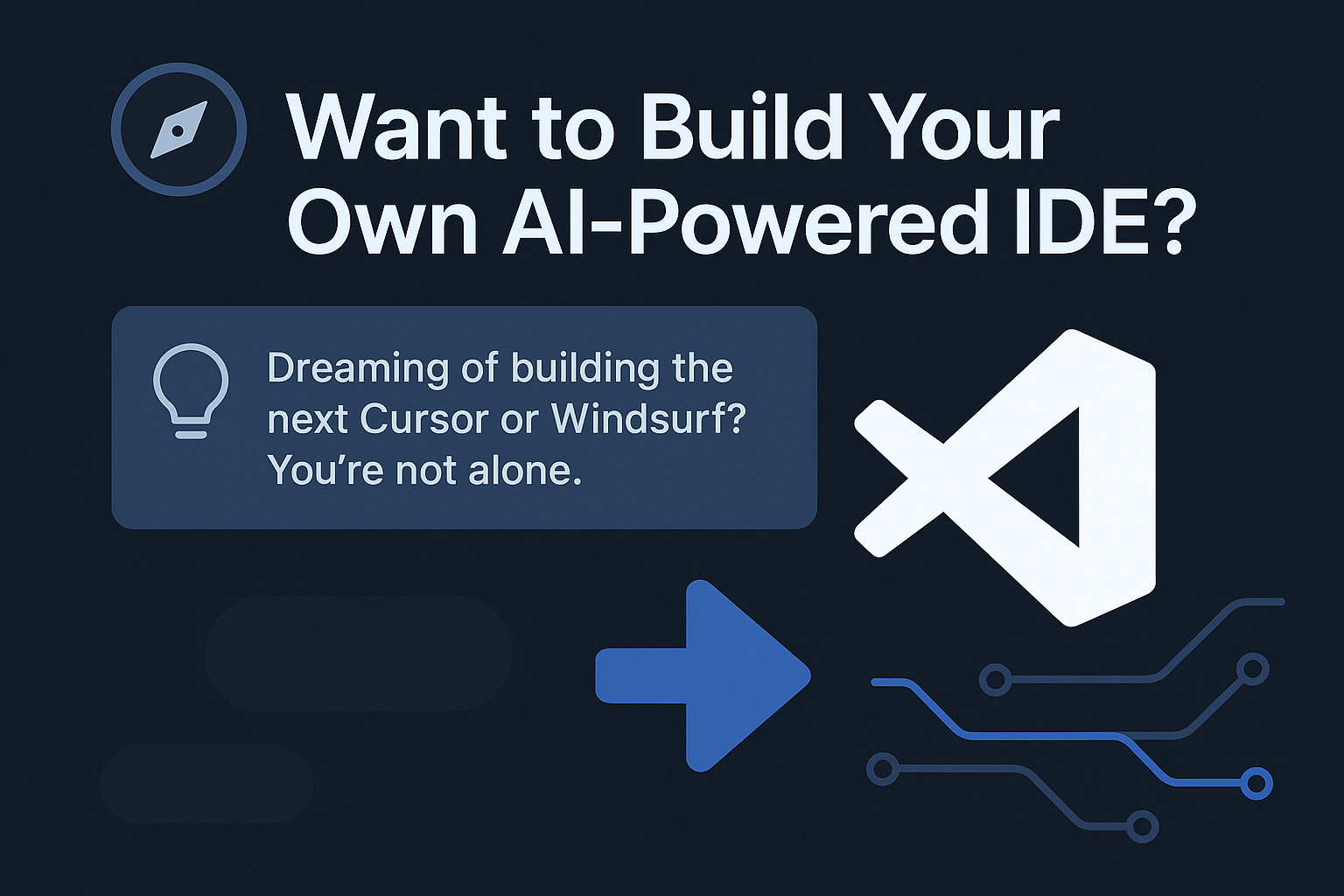How to Build an AI IDE from VSCode: Start with VSCodium by Vishal Pawar on July 29, 2025 965 views

🚀 Want to Build Your Own AI-Powered IDE? Start Here.
💡Dreaming of building the next Cursor or Windsurf? You’re not alone. But before you ship your own AI IDE, you need to understand what’s under the hood.

The truth is, most of these next-gen AI IDEs don’t start from scratch. They start with a fork of Visual Studio Code. But before you dive into adding AI magic, there’s one critical step: you need to understand how VSCode is built and packaged across platforms.
That’s where VSCodium comes in.
VSCodium is the open-source project that builds VSCode binaries (without Microsoft’s tracking and usage data collection). It’s also your gateway to understanding the guts of the CI/CD process—how builds are generated, how they’re signed, and how they’re shipped for Linux, macOS, and Windows.
In this post, we’ll explore the inner workings of the VSCodium repo, setting the foundation for you to confidently modify, extend, and ship your own AI-enhanced IDE.
💡Building an AI IDE isn’t one giant leap—it’s a series of smart steps.
🧠This post is Part 1 of a 3-part guide on turning VSCode into your own AI-powered IDE — without reinventing the wheel.
1️⃣
How to Build an AI IDE from VSCode: Start with VSCodium: VSCode, and the open-source path to AI IDEs. (You are here)
2️⃣
What a Modern CI/CD Pipeline Looks Like: A Deep Dive into VSCode: A DevOps deep dive into cross-platform builds.
3️⃣
VSCodium Linux Pipeline Technical Analysis: The arch-by-arch, job-by-job release strategy.
🔗 Start here. Follow along or jump to the part that fits your stack. Build your Cursor competitor with confidence.
🚀 Why the Best AI IDEs Don’t Start From Scratch
Reinventing the wheel is fun—until you realize VSCode already does 90% of what you need.
That’s why AI IDEs often start with something battle-tested.
Projects like Cursor, Windsurf, and Void aren’t building editors from zero—they’re building on top of VSCode.
Why?
- VSCode is feature-rich and battle-tested.
- It’s open source (minus branding and telemetry).
- It offers a mature extension system and customizable UI layers.
Instead of reinventing the editor, these projects fork VSCode and layer in AI-powered features—like chat panels, inline code suggestions, smart refactoring copilots, and even local LLM integrations.
🔄 What Is Forking?
Forking is the process of creating your own copy of a Git repository—typically on GitHub—so you can modify and experiment without affecting the original.
It gives you full control to reshape VSCode into an AI IDE tailored to your ideas, workflow, and hardware.
⚡ Before You Build: Forking VSCode the Right Way
If you want to build your own AI IDE, step one is to fork VSCode. But before you start hacking features in, you need to build the project locally and understand how it works under the hood.
VSCode Repo: https://github.com/microsoft/vscode
Here’s why:
- You’ll need to debug your own builds.
- You’ll probably want to package and distribute your app.
- You’ll likely hit weird issues that only make sense if you understand the build process.
And for that, the best learning playground is VSCodium.
🔧 Enter VSCodium: Your CI/CD Blueprint
💡CI (Continuous Integration): Automatically builds and tests code after every change to detect errors early.
💡CD (Continuous Deployment): Automatically delivers validated builds to production or staging environments.
VSCodium is a project that builds VSCode binaries without Microsoft branding or telemetry. It gives you a transparent, open CI/CD process you can learn from (or even fork).

VSCodium Repo: https://github.com/VSCodium/vscodium
What it gives you:
- CI workflows for Linux, macOS, Windows.
- Packaging steps for installers.
- Scripts for code signing and publishing.
📅 How VSCodium Builds VSCode Binaries
Before diving into AI integration or modifying your forked IDE, it’s important to understand how VSCodium builds and packages VSCode binaries.
💡 In the next article:
What a Moderwhat-a-modern-ci-cd-pipeline-looks-like:-a-deep-dive-into-vscoden CI/CD Pipeline Looks Like: A Deep Dive into VSCode, I’ll take you through the complete CI/CD workflow inside VSCodium—from fetching the VSCode source to packaging, signing, and publishing builds across Linux, macOS, and Windows. It’s a hands-on deep dive that shows how the real shipping engine works.
Stay tuned!
🤖 Making Your Pipeline AI-Ready
Once you understand VSCodium, you can start inserting your AI features into the mix.
Where to hook in AI:
- As extensions (e.g. Codeium, Cody (Sourcegraph),Tabnine, Blackbox AI, Rubberduck).
- Via custom panes or embedded terminals (e.g. Continue, Pieces App).
- In background services (e.g., a local LLM runner: Ollama).
CI/CD tweaks to support AI:
- Cache large AI models.
- Add platform-specific packaging for GPU access.
- Add telemetry or privacy settings.
✅ Lessons from Contributing to Void
These articles are the direct outcome of my attempt to contribute to Void, a Y Combinator–backed startup building an AI-enhanced IDE. While understanding their early-stage development needs—right after forking VSCode—I kept running into CI/CD issues. Builds failed when AI features were added. Debugging these problems forced me to learn how VSCode’s build process really works.
That journey led me to VSCodium, and everything clicked.
Once I understood how the pieces fit together, I could:
- Fix build issues faster.
- Add features without breaking releases.
- Contribute upstream.
🔐 The Takeaway
If you’re serious about building or contributing to an AI-enhanced IDE, don’t skip the boring stuff. Understanding the CI/CD pipeline is what separates a cool demo from a reliable dev tool.
Start with VSCodium. Master the build process. Then go beyond using AI tools—create them yourself.